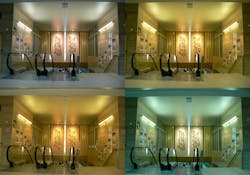WHITE BALANCE AND COLOR TEMPERATURE: A BALANCING ACT
White balance is something that consumer-grade and smartphone cameras now do automatically, but it is important to understand what it entails and why it is necessary.
Color Temperature
White balance is done with respect to color temperature, so this is a good place to start. The term color temperature stems from heating an ideal black-body radiator. For context, a blackbody is an object that neither reflects nor transmits any incident light. All the light is absorbed by the object which gives it a black appearance.
What all this means in more practical terms is if you heat an object, like a black-body, it will start to glow. It will typically appear more reddish at first and then get “white-hot” as its temperature continues to increase. The surface temperature of the object (in Kelvins) would reflect its color temperature.
How does this impact white balance and when would you ever deal with a black-body heated to many thousand Kelvins? This is just a model as many light sources, such as daylight and tungsten blubs, mimic the color of a heated black-body closely enough that we can attribute color temperatures to them. In the cases of other light sources that do not closely reflect the color temperatures of a true black-body, such as fluorescent bulbs, a correlated color temperature is used. In either case, most light sources indicate their actual or correlated color temperature. The table below highlights several light sources and their corresponding color temperature.
Since most lighting that is used is generally white in color, the range of color temperature differs by only a few thousand Kelvin. While this may be counterintuitive, “cooler” light sources that give off a blueish light are of a higher color temperature while “warmer” light sources that give off a more yellow or orange light are lower in color temperature.
White Balance
The reason white balance is so important is because it maintains color accuracy in an image and eliminates color cast. It is achieved by slightly adjusting the gain values for each color channel to account for the light source’s color temperature as well as the variance in each channel’s sensitivity.
Looking at a sensor’s color quantum efficiency (QE) curve, it is quite apparent that each channel requires a different amount of light to produce the same signal. Typically, the green channel is most sensitive, followed by the red channel, and finally the blue channel, which means the blue and red channels need more gain than the green channel to accurately depict a gray surface reflecting an equal amount of blue, green, and red light. However, if the light source has a higher color temperature, meaning it produces a blueish white light, the camera will need to apply less blue gain since there is more blue in the light.
Since most light sources publish their color temperature, that measurement can be fed into the camera to perform a light-based white balance. If the exact color temperature is unknown, generic profiles can be used such as fluorescent, incandescent, and daylight, to specify the scene’s color temperature.
All Lumenera cameras have the ability to perform a white balance based on the scene’s current lighting. They do so by using the Gray World Algorithm. It is done via software by grabbing a video frame, analyzing it, adjusting the color gains, and repeating until the colors in the image are balanced (resulting in an equal amount of Red, Blue, and Green in the image). It is best to put a neutral target (e.g. white or grey paper) in front of the camera before performing a color balance. For best results, the image exposure time should be adjusted so that the scene does not contain any saturated pixels (values at maximum brightness).
The key takeaway to white balancing is that, regardless of the method, it must be done to ensure proper color reproduction. It should also be repeated if lighting conditions change over the course of imaging. Custom white balancing can yield better results, especially if the color temperature of the light source is known. However, the built-in algorithms generally perform well when executed as indicated above.
For more information on adjusting camera settings for optimum performance in your particular application, please contact Lumenera’s imaging experts. They can also help with selecting the cameras to best meet your requirements. Reach out at [email protected]..
And, sign up for our newsletter to automatically receive regular updates from Lumenera.
